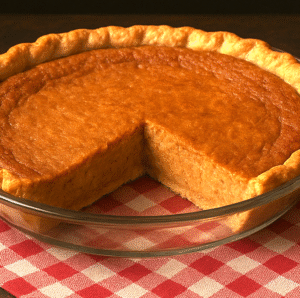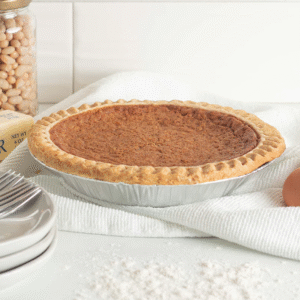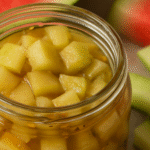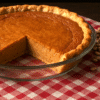Bean Pie: The Forgotten Poor Man’s Delight With a Twist

Both my momma and father were bean lovers—especially pinto beans. So much so, that rarely a week went by without my mom didn’t cook up a pound or so of those delicious red-speckled legumes. Perhaps it was because they were not only healthy and filling, but also cheap. Both grew up during the Great Depression and I suppose that frugality stuck with them.
I remember momma eating pintos left from the night before—cold, straight out of the fridge. When I asked how she could stand doing that, her reply was simply, “I like them that way”. Then she went on to tell me how her mother used to take leftover pintos and turn them into a pie for the next evening’s dessert. Now, if eating cold beans wasn’t bad enough for me, you can just imagine my thoughts about bean pie. Ugh!
 And though momma never made one herself, I often think about that conversation every time I put on a pot of Rancho Gordo pintos. Feeling the need to learn more about bean pie, I began digging into its history.
And though momma never made one herself, I often think about that conversation every time I put on a pot of Rancho Gordo pintos. Feeling the need to learn more about bean pie, I began digging into its history.
It seems that the pinto bean pie my grandmother made was a uniquely Southern dessert that found a home in Appalachian cooking. Reminiscent of sweet potato or pumpkin pie, bean pie has a custard-like filling of sugar, eggs, milk or cream, and spices such as vanilla, cinnamon, nutmeg—along with mashed beans. The use of leftover beans, in this case pintos, was not just frugality; it was ingenuity, turning what was on hand into a delightful dessert.
The earliest bean pie recipe I’ve uncovered was contributed by Mrs. Lucie Keith in the New Kentucky Home Cook Book (1884), compiled and published by the Methodist Episcopal Church, South, in Maysville, Kentucky:
Take one pint of white beans, throw in a pinch of soda while cooking—it makes them white and tender—run through a sieve, add one tea-cupful of sugar, one-half tea-cupful of butter, one-half tea-cupful of milk or cream, the yolks of three eggs. Stir well together, and bake in a puff paste. Make a méringue of the whites, place on the top, return to the oven to brown.
And here’s the twist: Mrs. Keith’s recipe calls for “white” beans, not pintos. What’s interesting is that the use of pinto beans in bean pie seems to have come about during the Depression era, when pintos were inexpensive, widely available, and already a staple in Southern kitchens. I can’t find a clear reason why Appalachian cooks shifted from white beans, but it may have been a simple matter of availability.
 Later, in the 1960s, bean pie took on a new life. Elijah Muhammad, leader of the nation of Islam, encouraged his followers to avoid traditional “soul food” dishes that were seen as unhealthy holdovers from slavery. Instead, he advocated for “the small navy bean—the little brown pink ones, and the white ones.” Out of this guidance grew the Nation of Islam’s version of the bean pie, made with navy beans, lightly spiced, and sold as both a wholesome food and a symbol of self-reliance.
Later, in the 1960s, bean pie took on a new life. Elijah Muhammad, leader of the nation of Islam, encouraged his followers to avoid traditional “soul food” dishes that were seen as unhealthy holdovers from slavery. Instead, he advocated for “the small navy bean—the little brown pink ones, and the white ones.” Out of this guidance grew the Nation of Islam’s version of the bean pie, made with navy beans, lightly spiced, and sold as both a wholesome food and a symbol of self-reliance.
Adrian Miller, author of the James Beard award-winning book Soul Food: The Surprising Story of an American Cuisine, One Plate at a Time, notes that it’s "not uncommon to see a Nation of Islam member selling bean pies on the street in Black neighborhoods.”
So bean pie, it seems, is very much a Southern dish with two stories: one forgotten by many as a “poor man’s dessert,” and another embraced by a community that turned it into a cultural and spiritual symbol. In honor of both, I’ve included recipes for an Appalachian pinto bean pie and a Muslim navy bean pie. Whichever one you choose to try, I suspect you’ll be surprised at just how delicious they are.




